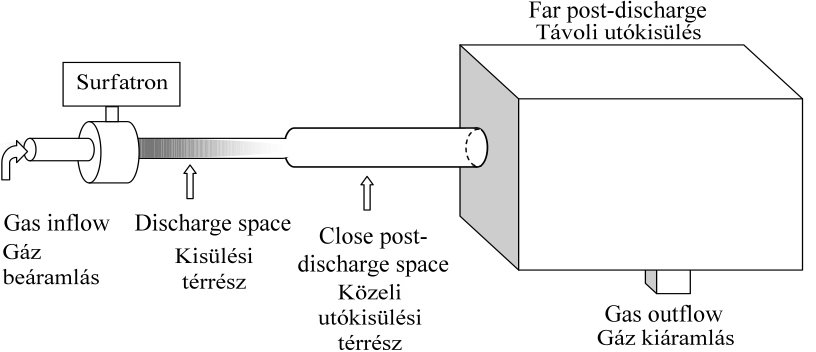Electrical discharges for biomedical and nano applications
Contact: Kinga KUTASI
Plasmas containing chemically active species meet several applications, e.g. the oxygen atom containing plasmas can be used for plasma based sterilization (bacteria inactivation and removal of biological contaminations from surfaces), as well as in synthesis of metal-oxide nanowires, oxide films deposition, functionalization of polymers, removal of organic impurities, selective etching of composites, wool treatment and surface activation; while the plasmas reach in CH radicals are applicable for biocompatible thin film deposition. In the application processes the synergetic effect between different species, such as chemically active species, ions and/or UV radiation can be observed. Thus each application requires different group of active species, which can be obtained by using different gas mixtures.
In case of reactive discharges, the reactive species created in the discharge can interact with the electrodes placed in the gas volume, thus making the operation of the discharge unstable. Therefore the electrodeless discharges constitute one of the most stable plasma sources. The new generation of electrodeless plasmas generated with high frequency electromagnetic waves, are those sustained with electromagnetic surface waves. With a non-ionizing surface wave, that propagates along the interface between the plasma column and its surrounding dielectric tube inhomogeneous large volume plasmas or long plasma columns can be sustained. The long plasma column discharges generated with surface waves are characterized by an unusual flexibility in operating conditions, depending on the tube radius (from ŸÖ0.5 mm to 150 mm) discharges can be produced at gas pressures as low as some 10−5Torr up to a few times atmospheric pressure. Several applications ¨C due to different reasons, such as too high gas temperature in the active discharge zone, or the presence of high energy ions that can modify the surfaces ¨Capply the flowing afterglow intead of the active discharge region. If the discharge is generated in flowing gas the active species created in the plasma can be transported by the gas flow to a remote reactor, which can have considerably larger diameters as the discharge tube, e.g. 60ŸÁ30ŸÁ28 cm3 comparing to the 6 mm diameter 10 cm long tube. At low pressures depending on the application either the smaller volume early-afterglow (that develops downstream the discharge in the same tube) or the larger volume post-discharge (late-afterglow) can be used, due to their different composition. At atmospheric pressure the plasma jet achieved downstream the discharge can be applied.

Postdischarge experimental setup.
Mivel minden alkalmazási folyamatban más-más részecskék, illetve részecske csoportok játszanak szerepet, a különböző alkalmazások különböző plazmaösszetételt igényelnek. A kisülések és azok utókisüléseinek különböző kisülési feltételek mellett történő részletes jellemzése lehetőséget ad arra, hogy az adott alkalmazáshoz ki tudjuk választani a legmegfelelőbb kisülési rendszert. A részecskesűrűségek ismerete a rendszer minden egyes pozíciójában segít megérteni a különböző részecskék és folyamatok szerepét az egyes alkalmazásokban. Az elmúlt években olyan kisüléseket és kisülési rendszereket vizsgáltunk, meghatározva a részecskék eloszlását az egész rendszer mentén, amelyek alkalmasak plazma alapú sterilizálásra, felületek kezelésére és nanostrukturák kialakítására. Ezek az alkalmazások a kisülésben lévő N, O atomokat, Ar+ ionokat és UV fotonokat (Ar rezonáns állapotú atomoknak, illetve NO(A) és NO(B) molekuláknak köszönhetően) hasznosítják.
Publikációk:



